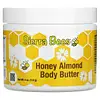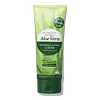What's inside
What's inside
 Key Ingredients
Key Ingredients

 Benefits
Benefits

 Concerns
Concerns

 Ingredients Side-by-side
Ingredients Side-by-side

Water
Skin ConditioningCetearyl Alcohol
EmollientCaprylic/Capric Triglyceride
MaskingCocos Nucifera Oil
MaskingHelianthus Annuus Seed Oil
EmollientGlycerin
HumectantButyrospermum Parkii Butter
Skin ConditioningGlyceryl Stearate
EmollientCetearyl Glucoside
EmulsifyingJojoba Esters
EmollientSimmondsia Chinensis Seed Oil
EmollientAloe Barbadensis Leaf Juice
Skin ConditioningPhytosteryl Oleate
Skin ConditioningSaccharide Isomerate
HumectantTocopherol
AntioxidantHoney
HumectantParfum
MaskingTetrasodium Glutamate Diacetate
Acacia Decurrens Flower Wax
EmollientXanthan Gum
EmulsifyingHelianthus Annuus Seed Cera
EmollientSodium Stearoyl Lactylate
EmulsifyingPhenoxyethanol
PreservativePolyglycerin-3
HumectantPhytosterols
Skin ConditioningAcacia Senegal Gum
MaskingTheobroma Cacao Seed Butter
EmollientMangifera Indica Seed Butter
Skin ConditioningHippophae Rhamnoides Fruit Extract
Skin ConditioningCamellia Sinensis Extract
AntioxidantEthylhexylglycerin
Skin ConditioningChamomilla Recutita Flower Extract
MaskingTheobroma Grandiflorum Seed Butter
Skin ConditioningSchinziophyton Rautanenii Kernel Oil
EmollientMoringa Oil/Hydrogenated Moringa Oil Esters
Skin ConditioningCitric Acid
BufferingSodium Citrate
BufferingCocos Nucifera Fruit Juice
EmollientWater, Cetearyl Alcohol, Caprylic/Capric Triglyceride, Cocos Nucifera Oil, Helianthus Annuus Seed Oil, Glycerin, Butyrospermum Parkii Butter, Glyceryl Stearate, Cetearyl Glucoside, Jojoba Esters, Simmondsia Chinensis Seed Oil, Aloe Barbadensis Leaf Juice, Phytosteryl Oleate, Saccharide Isomerate, Tocopherol, Honey, Parfum, Tetrasodium Glutamate Diacetate, Acacia Decurrens Flower Wax, Xanthan Gum, Helianthus Annuus Seed Cera, Sodium Stearoyl Lactylate, Phenoxyethanol, Polyglycerin-3, Phytosterols, Acacia Senegal Gum, Theobroma Cacao Seed Butter, Mangifera Indica Seed Butter, Hippophae Rhamnoides Fruit Extract, Camellia Sinensis Extract, Ethylhexylglycerin, Chamomilla Recutita Flower Extract, Theobroma Grandiflorum Seed Butter, Schinziophyton Rautanenii Kernel Oil, Moringa Oil/Hydrogenated Moringa Oil Esters, Citric Acid, Sodium Citrate, Cocos Nucifera Fruit Juice
Aloe Barbadensis Leaf Juice
Skin ConditioningCaprylic/Capric Triglyceride
MaskingGlycerin
HumectantHelianthus Annuus Seed Oil
EmollientCetearyl Alcohol
EmollientCetearyl Glucoside
EmulsifyingGlyceryl Stearate
EmollientGlyceryl Stearate Citrate
EmollientCucumis Sativus Fruit Extract
EmollientTocopherol
AntioxidantTocopheryl Acetate
AntioxidantButyrospermum Parkii Butter
Skin ConditioningXanthan Gum
EmulsifyingPhenoxyethanol
PreservativeCaprylyl Glycol
EmollientEthylhexylglycerin
Skin ConditioningAloe Barbadensis Leaf Juice, Caprylic/Capric Triglyceride, Glycerin, Helianthus Annuus Seed Oil, Cetearyl Alcohol, Cetearyl Glucoside, Glyceryl Stearate, Glyceryl Stearate Citrate, Cucumis Sativus Fruit Extract, Tocopherol, Tocopheryl Acetate, Butyrospermum Parkii Butter, Xanthan Gum, Phenoxyethanol, Caprylyl Glycol, Ethylhexylglycerin
Ingredients Explained
These ingredients are found in both products.
Ingredients higher up in an ingredient list are typically present in a larger amount.
Aloe Barbadensis Leaf Juice comes from leaves of the aloe plant. Aloe Barbadensis Leaf Juice is best known for helping to soothe sunburns. It is also anti-inflammatory, moisturizing, antiseptic, and can help heal wounds.
Aloe is packed with good stuff including Vitamins A, C, and E. These vitamins are antioxidants, which help fight free-radicals and the damage they may cause. Free-radicals are molecules that may damage your skin cells, such as pollution.
Aloe Barbadensis Leaf Juice also contains sugars. These sugars come in the form of monosaccharides and polysaccharides, folic acid, and choline. These sugars are able to help bind moisture to skin.
It also contains minerals such as calcium, 12 anthraquinones, fatty acids, amino acids, and Vitamin B12.
Learn more about Aloe Barbadensis Leaf JuiceThis ingredient is also known as shea butter. It is an effective skin hydrator and emollient.
Emollients help soothe and soften your skin. It does this by creating a protective film on your skin. This barrier helps trap moisture and keeps your skin hydrated. Emollients may be effective at treating dry or itchy skin.
Shea butter is rich in antioxidants. Antioxidants help fight free-radicals, or molecules that may harm the body. It is also full of fatty acids including stearic acid and linoleic acid. These acids help replenish the skin and keep skin moisturized.
While Shea Butter has an SPF rating of about 3-4, it is not a sunscreen replacement.
Shea butter may not be fungal acne safe. We recommend speaking with a professional if you have any concerns.
Learn more about Butyrospermum Parkii ButterThis ingredient is an emollient, solvent, and texture enhancer. It is considered a skin-softener by helping the skin prevent moisture loss.
It helps thicken a product's formula and makes it easier to spread by dissolving clumping compounds.
Caprylic Triglyceride is made by combining glycerin with coconut oil, forming a clear liquid.
While there is an assumption Caprylic Triglyceride can clog pores due to it being derived from coconut oil, there is no research supporting this.
Learn more about Caprylic/Capric TriglycerideCetearyl alcohol is a mixture of two fatty alcohols: cetyl alcohol and stearyl alcohol. It is mainly used as an emulsifier. Emulsifiers help prevent the separation of oils and products. Due to its composition, it can also be used to thicken a product or help create foam.
Cetearyl alcohol is an emollient. Emollients help soothe and hydrate the skin by trapping moisture.
Studies show Cetearyl alcohol is non-toxic and non-irritating. The FDA allows products labeled "alcohol-free" to have fatty alcohols.
This ingredient is usually derived from plant oils such as palm, vegetable, or coconut oils. There is debate on whether this ingredient will cause acne.
Due to the fatty acid base, this ingredient may not be Malassezia folliculitis safe.
Learn more about Cetearyl AlcoholCetearyl Glucoside is a surfactant and emulsifier. It can be produced from synthetic of natural sources of cetearyl alcohol and glucose.
Emulsifiers help prevent ingredients from separating, such as oils and waters. It can also be used to enhance the texture of products.
As a surfactant, Cetearyl Glucoside helps during the cleansing process. By gathering all the dirt and oils, it allows these molecules to be washed away easily.
Learn more about Cetearyl GlucosideEthylhexylglycerin (we can't pronounce this either) is commonly used as a preservative and skin softener. It is derived from glyceryl.
You might see Ethylhexylglycerin often paired with other preservatives such as phenoxyethanol. Ethylhexylglycerin has been found to increase the effectiveness of these other preservatives.
Glycerin is already naturally found in your skin. It helps moisturize and protect your skin.
A study from 2016 found glycerin to be more effective as a humectant than AHAs and hyaluronic acid.
As a humectant, it helps the skin stay hydrated by pulling moisture to your skin. The low molecular weight of glycerin allows it to pull moisture into the deeper layers of your skin.
Hydrated skin improves your skin barrier; Your skin barrier helps protect against irritants and bacteria.
Glycerin has also been found to have antimicrobial and antiviral properties. Due to these properties, glycerin is often used in wound and burn treatments.
In cosmetics, glycerin is usually derived from plants such as soybean or palm. However, it can also be sourced from animals, such as tallow or animal fat.
This ingredient is organic, colorless, odorless, and non-toxic.
Glycerin is the name for this ingredient in American English. British English uses Glycerol/Glycerine.
Learn more about GlycerinGlyceryl Stearate is a mix of glycerin and stearic acid.
It is used to stabilize the mixing of water and oil ingredients. By preventing these ingredients from separating, it can help elongate shelf life. It can also help thicken the product's texture.
As an emollient, it helps soften skin and supports barrier-replenishing ingredients.
In cosmetics, Glyceryl Stearate is often made from vegetable oils or synthetically produced.
This ingredient may not be fungal-acne safe
Fun fact: The human body also creates Glyceryl Stearate naturally.
Learn more about Glyceryl StearateHelianthus Annuus Seed Oil is the oil derived from the seeds of a Sunflower. Sunflower seed oil is non-fragrant. It is an emollient, meaning it helps to soften the skin.
Sunflower seed oil contains many fatty acids. The fatty acids found in sunflower seeds include (from highest amount to least): linoleic acid, myristic acid, palmitic acid, stearic acid, arachidic acid, oleic acid, and linolenic acid.
These fatty acids help the skin create ceramides. Ceramides play a role in repairing the skin barrier.
Helianthus Annuus Seed Oil helps moisturize the skin. This in turn helps the skin look more rejuvenated and smoother.
Sunflowers are rich in vitamin E.
Historians believe Indigenous cultures of North America domesticated sunflowers before corn. Thus they relied on sunflower oil for a variety of uses. One such use is moisturizing skin and hair.
Sunflower seed oil may not be fungal acne safe. We recommend speaking with a professional if you have any concerns.
Learn more about Helianthus Annuus Seed OilPhenoxyethanol is a preservative that has germicide, antimicrobial, and aromatic properties. Studies show that phenoxyethanol can prevent microbial growth. By itself, it has a scent that is similar to that of a rose.
It's often used in formulations along with Caprylyl Glycol to preserve the shelf life of products.
Tocopherol (also known as Vitamin E) is a common antioxidant used to help protect the skin from free-radicals and strengthen the skin barrier. It's also fat soluble - this means our skin is great at absorbing it.
Vitamin E also helps keep your natural skin lipids healthy. Your lipid skin barrier naturally consists of lipids, ceramides, and fatty acids. Vitamin E offers extra protection for your skin’s lipid barrier, keeping your skin healthy and nourished.
Another benefit is a bit of UV protection. Vitamin E helps reduce the damage caused by UVB rays. (It should not replace your sunscreen). Combining it with Vitamin C can decrease sunburned cells and hyperpigmentation after UV exposure.
You might have noticed Vitamin E + C often paired together. This is because it is great at stabilizing Vitamin C. Using the two together helps increase the effectiveness of both ingredients.
There are often claims that Vitamin E can reduce/prevent scarring, but these claims haven't been confirmed by scientific research.
Learn more about TocopherolXanthan gum is used as a stabilizer and thickener within cosmetic products. It helps give products a sticky, thick feeling - preventing them from being too runny.
On the technical side of things, xanthan gum is a polysaccharide - a combination consisting of multiple sugar molecules bonded together.
Xanthan gum is a pretty common and great ingredient. It is a natural, non-toxic, non-irritating ingredient that is also commonly used in food products.
Learn more about Xanthan Gum